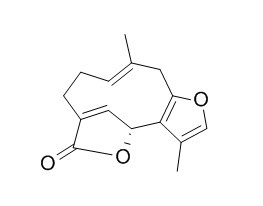Linderalactone
Linderalactone shows hepatoprotective activity against H2O2-induced oxidative damages on HepG2 cells with the EC(50) value of 98.0 microM. It shows significant inhibitory effects on superoxide anion generation by human neutrophils in response to fMLP/CB, the IC50 is 8.48 microg/mL.
Inquire / Order:
manager@chemfaces.com
Technical Inquiries:
service@chemfaces.com
Tel:
+86-27-84237783
Fax:
+86-27-84254680
Address:
1 Building, No. 83, CheCheng Rd., Wuhan Economic and Technological Development Zone, Wuhan, Hubei 430056, PRC
Providing storage is as stated on the product vial and the vial is kept tightly sealed, the product can be stored for up to
24 months(2-8C).
Wherever possible, you should prepare and use solutions on the same day. However, if you need to make up stock solutions in advance, we recommend that you store the solution as aliquots in tightly sealed vials at -20C. Generally, these will be useable for up to two weeks. Before use, and prior to opening the vial we recommend that you allow your product to equilibrate to room temperature for at least 1 hour.
Need more advice on solubility, usage and handling? Please email to: service@chemfaces.com
The packaging of the product may have turned upside down during transportation, resulting in the natural compounds adhering to the neck or cap of the vial. take the vial out of its packaging and gently shake to let the compounds fall to the bottom of the vial. for liquid products, centrifuge at 200-500 RPM to gather the liquid at the bottom of the vial. try to avoid loss or contamination during handling.
Front Pharmacol.2017, 8:673
Curr Top Med Chem.2020, 20(21):1898-1909.
J. Soc. Cosmet. Sci. Korea2016, 163-171
Anesth Pain Med (Seoul).2020, 15(4):478-485.
Antioxidants (Basel).2023, 12(2):447.
Archives of Biological sciences2022, 00:21-21
J Agric Food Chem.2024, acs.jafc.4c01387.
Comput Biol Chem.2019, 83:107096
Front Pharmacol.2024, 15:1455805.
Anal Bioanal Chem. 2016, 408(15)
Related and Featured Products
Nat Prod Res. 2005 Apr;19(3):283-6.
Anti-inflammatory furanogermacrane sesquiterpenes from Neolitsea parvigemma.[Pubmed:
15702642]
METHODS AND RESULTS:
Six furanogermacrane sesquiterpenes, pseudoneolinderane (1), Linderalactone (2), zeylanidine (3), zeylanicine (4), deacetylzeylanidine (5), and neolitrane (6), isolated from the stems of Neolitsea parvigemma, were tested for anti-inflammatory activities.
CONCLUSIONS:
Among them, 1 and 2 showed significant inhibitory effects on superoxide anion generation by human neutrophils in response to fMLP/CB. The IC50 of 1 and 2 were found to be 3.21 and 8.48 microg/mL, respectively.
J Nat Prod. 2009 Aug;72(8):1497-501.
Sesquiterpene lactones from the root tubers of Lindera aggregata.[Pubmed:
19639966]
Phytochemical investigation of the root tubers of Lindera aggregata resulted in the isolation of five new sesquiterpene lactones, linderagalactones A-E (1-5), along with eight known sesquiterpenoids, 3-eudesmene-1beta,11-diol, hydroxylindestenolide, strychnistenolide, hydroxyisogermafurenolide, atractylenolide III, linderane, neoLinderalactone, and Linderalactone.
METHODS AND RESULTS:
The structures and relative configurations of 1-5 were determined by spectroscopic methods, especially HRESIMS and 2D NMR techniques. The absolute configurations of 1-4 were defined by comparison of quantum chemical TDDFT calculated and experimental ECD spectra. Linderagalactone A (1) is a halogenated sesquiterpene lactone possessing a unique rearranged carbon skeleton. Linderagalactone E (5), linderane, hydroxylindestenolide, and Linderalactone showed hepatoprotective activity against H2O2-induced oxidative damages on HepG2 cells with EC(50) values of 67.5, 167.0, 42.4, and 98.0 microM, respectively.
Zhongguo Zhong Yao Za Zhi. 2001 Nov;26(11):765-7.
Studies on constituents of the leaves of Lindera aggregata (Sims) Kosterm.[Pubmed:
12776349]
To study the antibacterial and anti-inflammatory constituents of the leaves of Lindera aggrega.
METHODS AND RESULTS:
Compounds were isolated by colum chromatography, and the structures were identified by spectroscopic methods.
Six compounds were isolated and identified as mixture of 6-Acetyllindenanolide B-1 and B-2(I), dehydrolindestrenolide (II), hydroxylinderstrenolide (III), Linderalactone (IV), kameofero (V), beta-sitosterol (VI).
CONCLUSIONS:
These compounds were obtained from the leaves of Lindera aggregata for the first time.



